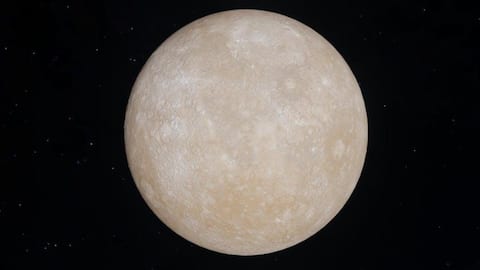Mercury's hidden treasure: A possible 11-mile-deep diamond layer
What's the story
Recent research suggests that Mercury, the smallest planet in our solar system and closest to the sun, may conceal a layer of diamonds up to 18 km (17.7km) thick beneath its surface. These diamonds are believed to have formed approximately 4.5 billion years ago, shortly after Mercury itself coalesced from a cloud of dust and gas in a high-pressure, high-temperature environment. The young planet likely had a graphite crust floating over a deep magma ocean at this time.
Diamond formation
Recreating Mercury's intense environment: The anvil press machine
The research team, led by Bernard Charlier, head of the Department of Geology at the University of Liege in Belgium, replicated Mercury's intense environment using an anvil press machine. This machine is typically used for studying materials under extreme pressure and for producing synthetic diamonds. Charlier explained that the press allows them to subject small samples to the high pressure and temperature conditions expected deep within Mercury's mantle.
Synthetic mixture
Unveiling Mercury's diamond layer: The experimental process
The researchers inserted a synthetic mixture of elements, including silicon, titanium, magnesium and aluminum, into a graphite capsule to mimic Mercury's early interior composition. This capsule was then subjected to pressures nearly 70,000 times greater than those on Earth's surface and temperatures up to 2,000 degrees Celsius (3,630 degrees Fahrenheit). After melting the sample under these extreme conditions, they observed that the graphite had transformed into diamond crystals under an electron microscope.
Planetary insights
Mercury's unique characteristics and planetary evolution
This discovery could provide insight into not only Mercury's hidden secrets but also planetary evolution and the internal structure of exoplanets with similar characteristics. Mercury is unique among terrestrial planets due to its proximity to the sun and consequent low oxygen levels which affect its chemistry. It is known for its large metallic core which takes up 85% of its radius, making it the second densest planet after Earth.
Planetary exploration
Mercury's unexplored terrain: A call for further research
Mercury is one of the least explored terrestrial planets. The last mission to Mercury, NASA's MESSENGER, orbited the planet from March 2011 to April 2015, gathering data about its geology, chemistry and magnetic field. Yanhao Lin, a staff scientist at the Center for High Pressure Science and Technology Advanced Research in Beijing and coauthor of the study added that there are very few studies about the inside of Mercury.
Sulfur influence
The role of sulfur in mercury's diamond formation
The researchers' experiment was informed by previous studies showing that sulfur is present on Mercury. Charlier explained that sulfur on Mercury lowered the melting point of their sample, revealing conditions that differ from those on Earth. This lower melting point is advantageous for diamond formation, as diamonds form better under high pressure but lower temperature conditions.
Diamond estimates
The potential diamond layer: A cautionary note
Charlier cautioned that their estimate of a 15 to 18km (9.3 to 17.86km) thick diamond layer could change as diamond formation may still be ongoing as Mercury's core continues to cool. The size of individual diamonds remains unknown. Mining these diamonds would be impossible due to their depth of approximately 500km (499km), but Charlier suggested that some diamonds might reach the surface through volcanic activity, similar to processes on Earth.
